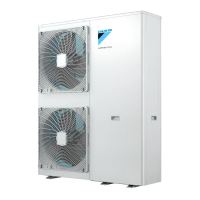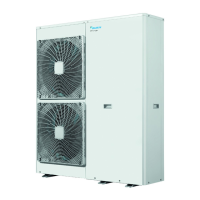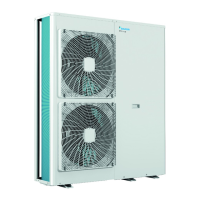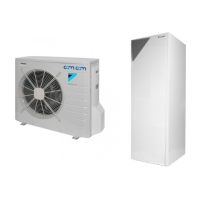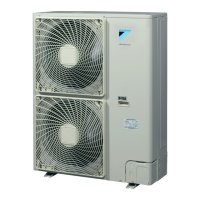5 Application guidelines
Installer reference guide
20
EBLQ+EDLQ011~016CAV3+W1 + EK(2)CB07CAV3 +
EKMBUHCA3V3+9W1
Daikin Altherma low temperature monobloc
4P522034-1 – 2018.01
L
N
H
Com
A
K2AK1A
X2M
B
TI
K2AK1A
Outdoor/Auto/Boiler
1 4 X Y
Control box
B
TI
Boiler thermostat input
A Auxiliary contact (normal closed)
H Heating demand room thermostat (optional)
K1A Auxiliary relay for activation of outdoor unit (field supply)
K2A Auxiliary relay for activation of boiler (field supply)
Outdoor Outdoor unit
Auto Automatic
Boiler Boiler
Control box Control box
NOTICE
▪ Make sure the auxiliary contact has enough differential
or time delay to prevent frequent changeover between
outdoor unit and auxiliary boiler.
▪ If the auxiliary contact is an outdoor temperature
thermostat, install the thermostat in the shadow so that
it is NOT influenced or turned ON/OFF by direct
sunlight.
▪ Frequent changeover may cause corrosion of the
auxiliary boiler. Contact the manufacturer of the
auxiliary boiler for more information.
5.4 Setting up the domestic hot water
tank
5.4.1 System layout – Standalone DHW tank
FHL1
FHL2
FHL3
M
a b c
d
e
i
f
g
d
h
j
k
a Outdoor unit
b Heat exchanger
c Pump
d Shut‑off valve
e Backup heater (option)
f Control box
g User interface
h Motorised 3‑way valve
i Domestic hot water tank
j Heat exchanger coil
k Collector (field supply)
FHL1...3 Underfloor heating
5.4.2 Selecting the volume and desired
temperature for the DHW tank
People experience water as hot when its temperature is 40°C.
Therefore, the DHW consumption is always expressed as equivalent
hot water volume at 40°C. However, you can set the DHW tank
temperature at a higher temperature (example: 53°C), which is then
mixed with cold water (example: 15°C).
Selecting the volume and desired temperature for the DHW tank
consists of:
1 Determining the DHW consumption (equivalent hot water
volume at 40°C).
2 Determining the volume and desired temperature for the DHW
tank.
Determining the DHW consumption
Answer the following questions and calculate the DHW consumption
(equivalent hot water volume at 40°C) using typical water volumes:
Question Typical water volume
How many showers are needed
per day?
1shower = 10min×10l/min =
100l
How many baths are needed per
day?
1bath = 150l
How much water is needed at the
kitchen sink per day?
1sink = 2min×5l/min = 10l
Are there any other domestic hot
water needs?
—
Example: If the DHW consumption of a family (4 persons) per day
is as follows:
▪ 3 showers
▪ 1 bath
▪ 3 sink volumes
Then the DHW consumption = (3×100l)+(1×150l)+(3×10l)=480l
Determining the volume and desired temperature for the DHW
tank
Formula Example
V
1
=V
2
+V
2
×(T
2
−40)/(40−T
1
) If:
▪ V
2
=180l
▪ T
2
=54°C
▪ T
1
=15°C
Then V
1
=280l
V
2
=V
1
×(40−T
1
)/(T
2
−T
1
) If:
▪ V
1
=480l
▪ T
2
=54°C
▪ T
1
=15°C
Then V
2
=307l
V
1
DHW consumption (equivalent hot water volume at 40°C)
V
2
Required DHW tank volume if only heated once
T
2
DHW tank temperature
T
1
Cold water temperature
Possible DHW tank volumes
Type Possible volumes
Standalone DHW tank ▪ 150l
▪ 180l
▪ 200l
▪ 250l
▪ 300l
▪ 500l
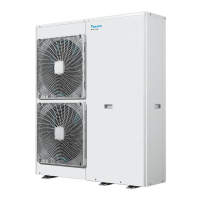
